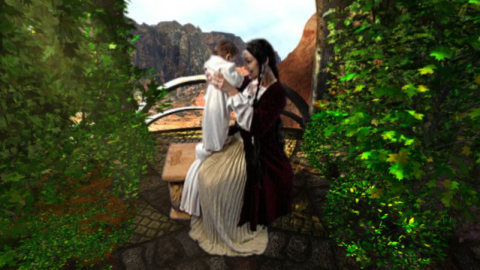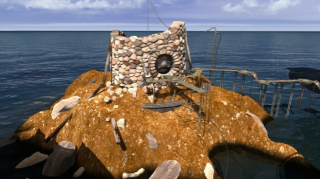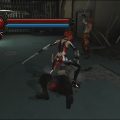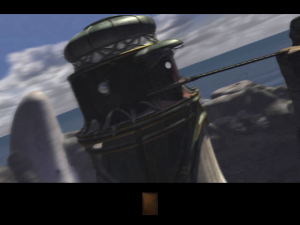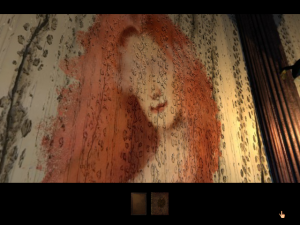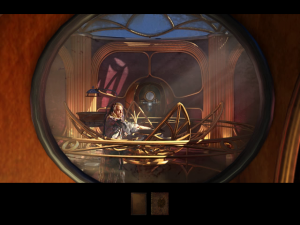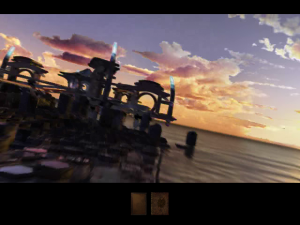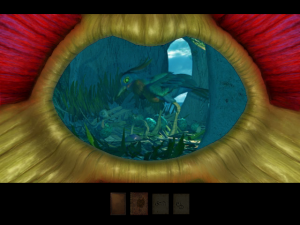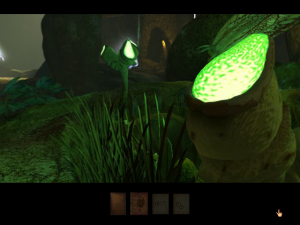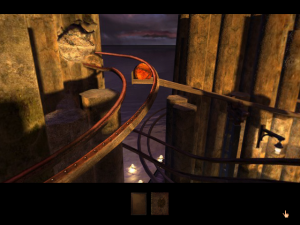After finishing Riven, Cyan was too busy chasing the wild dream that was going to be Uru to have time to make the next numbered installment in the Myst franchise. On the other hand, the fans were clamoring for a sequel, so the job was given to Presto Studios, who were not exactly new to the adventure genre since they had already created The Journeyman Project franchise. The game still doesn’t allow free movement, but Myst III does allow you to look around in 360° in each spot, much like the third game from Presto’s own series. In other words, instead of navigating from photo to photo, you’re moving from sphere to sphere.
Myst III tells the story of Saavedro, a native of one of Atrus’ ages that was wronged by Atrus’ two sons. To get his revenge, Saavedro steals the book of Releeshan, an age meant to be a new peaceful home for the remnants of the D’ni race. You once again play as the nameless character from the first two games and it’s up to you to get the book back. Rand Miller reprises his role as Atrus. Sadly, the part of Catherine is played by someone new this time. The role of Saavedro is played by Brad Dourif, who was nominated for an Oscar in One Flew Over the Cuckoo’s Nest. Playing nut jobs seems to be his thing, since that’s pretty much how he acts here.
As soon as Exile begins… a few things seem out of place. First, while the opening FMV is a very high quality shot of Atrus writing at his desk and brooding about the past, what he is actually looking at while pondering are drawings of his family. Those drawings look awkward and very out of place, especially inside a fullscreen video next to a flesh-and-blood human being. This is strange since there were already photographs in Riven. Furthermore, the video ends in a dramatic crescendo of chanting voices that, while well executed, doesn’t fit the mood of Atrus’s monologue at all. Jack Wall (who later worked on Jade Empire and Mass Effect 2) was put in charge of Exile’s soundtrack and, while he is extremely competent, his style is a big contrast compared to the other games, despite visibly (audibly?) having tried to stick to similar themes. A little bit later, in the first moments of the game, Catherine and her baby Yeesha get stuck in a weird three second loop where she throws her baby in the air again and again, while you can hear distressing gurgles coming from the baby. These may seem like small details, but a few minutes after the game has begun, you can already see that some notes are off-key.
The graphics are neither a step up nor a step down from Riven. While the ability to look in any direction is nice and the game is certainly more colorful, the images seem to have been compressed and look a bit blurry compared to Riven’s crisp, almost photorealistic, stills. This is despite the fact that Exile relies on better hardware and uses up more space. Maybe it is a concession related to creating 360° stills? Another problem with spherical images is that there is a slight delay when moving from one spot to the other. This can get really aggravating when trying to quickly move between important areas.
You start in J’nanin, a training age built by Atrus to show his unruly sons the Art of writing. J’nanin is a rocky beach and acts as a hub that leads to the three other main ages of the game. Exile is structured much like the first Myst, since you have to solve an easier riddle to gain access to another age where you’ll have to face harder brainteasers in a similar vein. Each age has its own type of puzzle and finishing them will give you a symbol needed to access the final area. The extra reward for solving each age is a really cool theme park ride, much like the transitions between islands in Riven.
The Ages
Voltaic
Voltaic is a barren rocky age and, as the name might suggest, it is an age all about harnessing various types of energy and distributing it in the correct proportions to other machines. You should know the drill: a dam, steam, valves, levers, the works. The puzzles here are fairly traditional Myst fare, so there’s not much more to say about them. Finishing it will let you ride a wire-guided airship through a canyon onto a floating island.
Edanna
A verdant world set inside a large bone-like pillar lost in the middle of the sea. A giant bird creature has built her nest at the top of the pillar, right near your link-in point. You will eventually need to save her from a carnivorous plant so she can get back to tending to her babies. This age also features the squee, a squirrel-like creature that emits a call that is the most distinctive sound in Exile, both weird and cute. Certain plants react to that sound by expanding, creating new passages. The little beast is cute enough, but all empathy I had for it disappeared once I saw that they were trying to commercialize his sorry mug by putting it on merchandise. I mean, there’s an ad right there on the back of the jewel case, which is bad enough on its own. Edanna involves manipulating machine-like plants to move around. For example, some plants project reflected light and others react by stretching out when illuminated, forming a bridge. A giant jumping leaf is even nice enough to act like an elevator. The jungle looks fabulous, with lots of flowers and mushrooms glowing orange, green and purple. On the flipside, navigating inside tree trunks and narrow passages at weird angles through lots of visual clutter is very confusing. Completing this age will get you a free ride from the giant bird mommy and a toboggan slide.
Amateria
A pagoda-themed age set in a perpetual twilight storm. The oriental theme is a bit too obvious and isn’t really part of Cyan’s leitmotiv of going for architecture as alien as possible. This totally gives away the fact that Exile was made by a third party, at least to my eyes. But why complain, since it is the most gorgeous of Exile’s ages: bathed in purple light, full of glowing green crystals and surrounded by the sound of rolling thunder. Geometric shapes like hexagons and perfect spheres are also a theme here. All of the puzzles involve board game inspired control stations where the goal is to move large spheres across railings without breaking them or dropping them in the water. The highlight involves entering inside one of the spheres and going on a pinball ride through all of the paths you’ve previously created, which is quite an awesome sight. Amateria is a lot like playing mousetrap.
Completing all three ages will let you enter Narayan, Saavedro’s homeland, where your actions will determine the game’s finale. There is one last puzzle which will check to see if you’ve learned your “lessons” from Atrus’ training ages. Although the concept of the final puzzle is really good, it requires you to input a lot of codes in a way that is not very clearly explained. This can lead to a lot of trial and error, something I don’t like to see near the end of a game. Once again there is a clear good ending and a few bad ones involving you acting like a jerk or ending on the wrong side of Saavedro’s sledgehammer. While the ages are very nice and the puzzles mostly satisfying, Exile’s puzzles have not been as well integrated as those of Riven. The objects obey their own logic, but other than the fact that the ages are supposed to be puzzle ages to “train” Sirrus and Achenar, there is no deeper in-world purpose to anything found in Exile. The puzzles are just there, waiting to be solved, as some detractors of the Myst franchise would lament. The only bits of extra information to be gleaned come from Saavedro’s notebook, murals and his recorded monologues.
Exile ended being the very last game developed by Presto Studios. While the game obtained good reviews and sold more than a million copies, it was deemed to be a commercial failure. It’s hard to see what they were expecting, since by 2001 the adventure game genre was already in decline.
Myst III is a good game, but it’s hard not to compare it to Riven, which in many ways looked as good if not better, except maybe for the 360 degree thing. Exile is also a much less intricate experience than Riven, where every detail is accounted for. Myst III contains all the ingredients that are typical of the franchise and yet still somehow ends up feeling a little bit unofficial. A competent game, but the subtle touch of Cyan is missing.


